Xue Bai
Towards Efficient Real-Time Video Motion Transfer via Generative Time Series Modeling
Apr 07, 2025Abstract:We propose a deep learning framework designed to significantly optimize bandwidth for motion-transfer-enabled video applications, including video conferencing, virtual reality interactions, health monitoring systems, and vision-based real-time anomaly detection. To capture complex motion effectively, we utilize the First Order Motion Model (FOMM), which encodes dynamic objects by detecting keypoints and their associated local affine transformations. These keypoints are identified using a self-supervised keypoint detector and arranged into a time series corresponding to the successive frames. Forecasting is performed on these keypoints by integrating two advanced generative time series models into the motion transfer pipeline, namely the Variational Recurrent Neural Network (VRNN) and the Gated Recurrent Unit with Normalizing Flow (GRU-NF). The predicted keypoints are subsequently synthesized into realistic video frames using an optical flow estimator paired with a generator network, thereby facilitating accurate video forecasting and enabling efficient, low-frame-rate video transmission. We validate our results across three datasets for video animation and reconstruction using the following metrics: Mean Absolute Error, Joint Embedding Predictive Architecture Embedding Distance, Structural Similarity Index, and Average Pair-wise Displacement. Our results confirm that by utilizing the superior reconstruction property of the Variational Autoencoder, the VRNN integrated FOMM excels in applications involving multi-step ahead forecasts such as video conferencing. On the other hand, by leveraging the Normalizing Flow architecture for exact likelihood estimation, and enabling efficient latent space sampling, the GRU-NF based FOMM exhibits superior capabilities for producing diverse future samples while maintaining high visual quality for tasks like real-time video-based anomaly detection.
MaskMoE: Boosting Token-Level Learning via Routing Mask in Mixture-of-Experts
Jul 13, 2024Abstract:Scaling model capacity enhances its capabilities but significantly increases computation. Mixture-of-Experts models (MoEs) address this by allowing model capacity to scale without substantially increasing training or inference costs. Despite their promising results, MoE models encounter several challenges. Primarily, the dispersion of training tokens across multiple experts can lead to underfitting, particularly for infrequent tokens. Additionally, while fixed routing mechanisms can mitigate this issue, they compromise on the diversity of representations. In this paper, we propose MaskMoE, a method designed to enhance token-level learning by employing a routing masking technique within the Mixture-of-Experts model. MaskMoE is capable of maintaining representation diversity while achieving more comprehensive training. Experimental results demonstrate that our method outperforms previous dominant Mixture-of-Experts models in both perplexity (PPL) and downstream tasks.
Enhancing Bandwidth Efficiency for Video Motion Transfer Applications using Deep Learning Based Keypoint Prediction
Mar 17, 2024Abstract:We propose a deep learning based novel prediction framework for enhanced bandwidth reduction in motion transfer enabled video applications such as video conferencing, virtual reality gaming and privacy preservation for patient health monitoring. To model complex motion, we use the First Order Motion Model (FOMM) that represents dynamic objects using learned keypoints along with their local affine transformations. Keypoints are extracted by a self-supervised keypoint detector and organized in a time series corresponding to the video frames. Prediction of keypoints, to enable transmission using lower frames per second on the source device, is performed using a Variational Recurrent Neural Network (VRNN). The predicted keypoints are then synthesized to video frames using an optical flow estimator and a generator network. This efficacy of leveraging keypoint based representations in conjunction with VRNN based prediction for both video animation and reconstruction is demonstrated on three diverse datasets. For real-time applications, our results show the effectiveness of our proposed architecture by enabling up to 2x additional bandwidth reduction over existing keypoint based video motion transfer frameworks without significantly compromising video quality.
InfoEntropy Loss to Mitigate Bias of Learning Difficulties for Generative Language Models
Nov 01, 2023Abstract:Generative language models are usually pretrained on large text corpus via predicting the next token (i.e., sub-word/word/phrase) given the previous ones. Recent works have demonstrated the impressive performance of large generative language models on downstream tasks. However, existing generative language models generally neglect an inherent challenge in text corpus during training, i.e., the imbalance between frequent tokens and infrequent ones. It can lead a language model to be dominated by common and easy-to-learn tokens, thereby overlooking the infrequent and difficult-to-learn ones. To alleviate that, we propose an Information Entropy Loss (InfoEntropy Loss) function. During training, it can dynamically assess the learning difficulty of a to-be-learned token, according to the information entropy of the corresponding predicted probability distribution over the vocabulary. Then it scales the training loss adaptively, trying to lead the model to focus more on the difficult-to-learn tokens. On the Pile dataset, we train generative language models at different scales of 436M, 1.1B, and 6.7B parameters. Experiments reveal that models incorporating the proposed InfoEntropy Loss can gain consistent performance improvement on downstream benchmarks.
Gated Driver Attention Predictor
Aug 01, 2023Abstract:Driver attention prediction implies the intention understanding of where the driver intends to go and what object the driver concerned about, which commonly provides a driving task-guided traffic scene understanding. Some recent works explore driver attention prediction in critical or accident scenarios and find a positive role in helping accident prediction, while the promotion ability is constrained by the prediction accuracy of driver attention maps. In this work, we explore the network connection gating mechanism for driver attention prediction (Gate-DAP). Gate-DAP aims to learn the importance of different spatial, temporal, and modality information in driving scenarios with various road types, occasions, and light and weather conditions. The network connection gating in Gate-DAP consists of a spatial encoding network gating, long-short-term memory network gating, and information type gating modules. Each connection gating operation is plug-and-play and can be flexibly assembled, which makes the architecture of Gate-DAP transparent for evaluating different spatial, temporal, and information types for driver attention prediction. Evaluations on DADA-2000 and BDDA datasets verify the superiority of the proposed method with the comparison with state-of-the-art approaches. The code is available on https://github.com/JWFangit/Gate-DAP.
ViTASD: Robust Vision Transformer Baselines for Autism Spectrum Disorder Facial Diagnosis
Oct 30, 2022Abstract:Autism spectrum disorder (ASD) is a lifelong neurodevelopmental disorder with very high prevalence around the world. Research progress in the field of ASD facial analysis in pediatric patients has been hindered due to a lack of well-established baselines. In this paper, we propose the use of the Vision Transformer (ViT) for the computational analysis of pediatric ASD. The presented model, known as ViTASD, distills knowledge from large facial expression datasets and offers model structure transferability. Specifically, ViTASD employs a vanilla ViT to extract features from patients' face images and adopts a lightweight decoder with a Gaussian Process layer to enhance the robustness for ASD analysis. Extensive experiments conducted on standard ASD facial analysis benchmarks show that our method outperforms all of the representative approaches in ASD facial analysis, while the ViTASD-L achieves a new state-of-the-art. Our code and pretrained models are available at https://github.com/IrohXu/ViTASD.
A Two-Stage Approach to Device-Robust Acoustic Scene Classification
Nov 03, 2020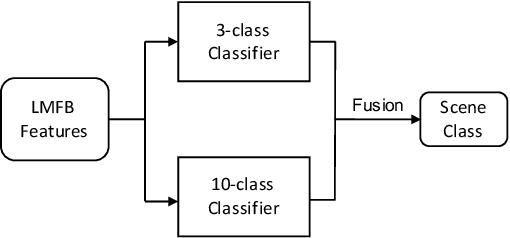

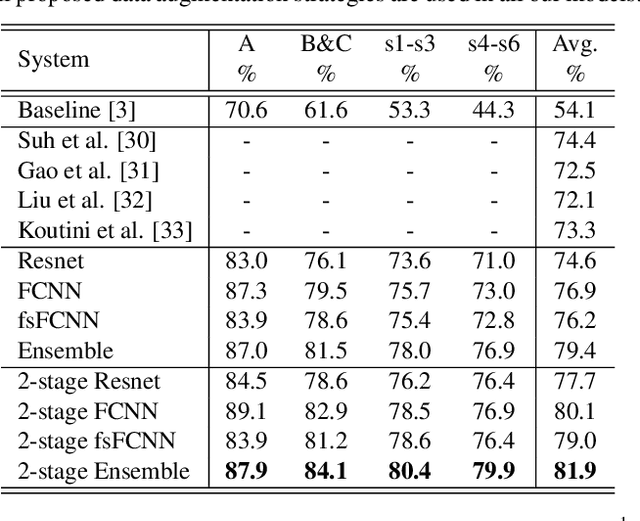
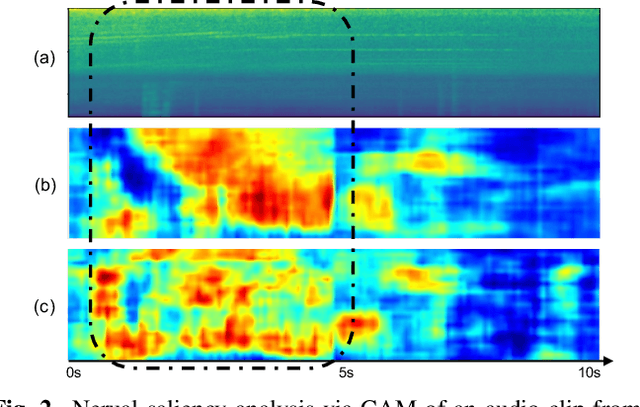
Abstract:To improve device robustness, a highly desirable key feature of a competitive data-driven acoustic scene classification (ASC) system, a novel two-stage system based on fully convolutional neural networks (CNNs) is proposed. Our two-stage system leverages on an ad-hoc score combination based on two CNN classifiers: (i) the first CNN classifies acoustic inputs into one of three broad classes, and (ii) the second CNN classifies the same inputs into one of ten finer-grained classes. Three different CNN architectures are explored to implement the two-stage classifiers, and a frequency sub-sampling scheme is investigated. Moreover, novel data augmentation schemes for ASC are also investigated. Evaluated on DCASE 2020 Task 1a, our results show that the proposed ASC system attains a state-of-the-art accuracy on the development set, where our best system, a two-stage fusion of CNN ensembles, delivers a 81.9% average accuracy among multi-device test data, and it obtains a significant improvement on unseen devices. Finally, neural saliency analysis with class activation mapping (CAM) gives new insights on the patterns learnt by our models.
Device-Robust Acoustic Scene Classification Based on Two-Stage Categorization and Data Augmentation
Aug 27, 2020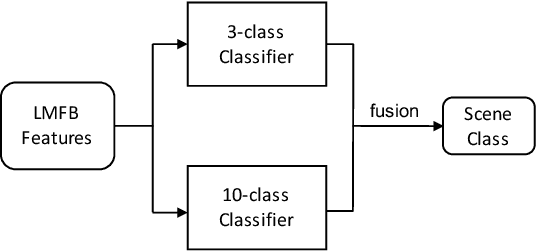
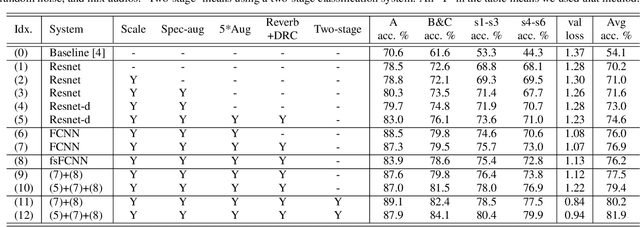
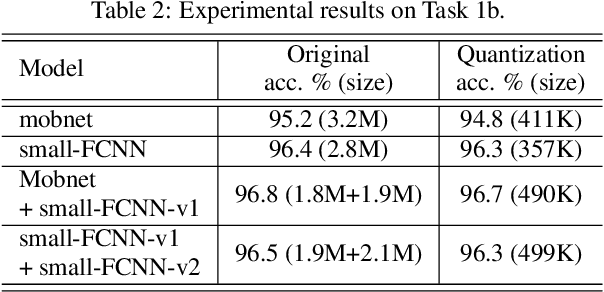
Abstract:In this technical report, we present a joint effort of four groups, namely GT, USTC, Tencent, and UKE, to tackle Task 1 - Acoustic Scene Classification (ASC) in the DCASE 2020 Challenge. Task 1 comprises two different sub-tasks: (i) Task 1a focuses on ASC of audio signals recorded with multiple (real and simulated) devices into ten different fine-grained classes, and (ii) Task 1b concerns with classification of data into three higher-level classes using low-complexity solutions. For Task 1a, we propose a novel two-stage ASC system leveraging upon ad-hoc score combination of two convolutional neural networks (CNNs), classifying the acoustic input according to three classes, and then ten classes, respectively. Four different CNN-based architectures are explored to implement the two-stage classifiers, and several data augmentation techniques are also investigated. For Task 1b, we leverage upon a quantization method to reduce the complexity of two of our top-accuracy three-classes CNN-based architectures. On Task 1a development data set, an ASC accuracy of 76.9\% is attained using our best single classifier and data augmentation. An accuracy of 81.9\% is then attained by a final model fusion of our two-stage ASC classifiers. On Task 1b development data set, we achieve an accuracy of 96.7\% with a model size smaller than 500KB. Code is available: https://github.com/MihawkHu/DCASE2020_task1.
An Acoustic Segment Model Based Segment Unit Selection Approach to Acoustic Scene Classification with Partial Utterances
Jul 31, 2020



Abstract:In this paper, we propose a sub-utterance unit selection framework to remove acoustic segments in audio recordings that carry little information for acoustic scene classification (ASC). Our approach is built upon a universal set of acoustic segment units covering the overall acoustic scene space. First, those units are modeled with acoustic segment models (ASMs) used to tokenize acoustic scene utterances into sequences of acoustic segment units. Next, paralleling the idea of stop words in information retrieval, stop ASMs are automatically detected. Finally, acoustic segments associated with the stop ASMs are blocked, because of their low indexing power in retrieval of most acoustic scenes. In contrast to building scene models with whole utterances, the ASM-removed sub-utterances, i.e., acoustic utterances without stop acoustic segments, are then used as inputs to the AlexNet-L back-end for final classification. On the DCASE 2018 dataset, scene classification accuracy increases from 68%, with whole utterances, to 72.1%, with segment selection. This represents a competitive accuracy without any data augmentation, and/or ensemble strategy. Moreover, our approach compares favourably to AlexNet-L with attention.
 Add to Chrome
Add to Chrome Add to Firefox
Add to Firefox Add to Edge
Add to Edge